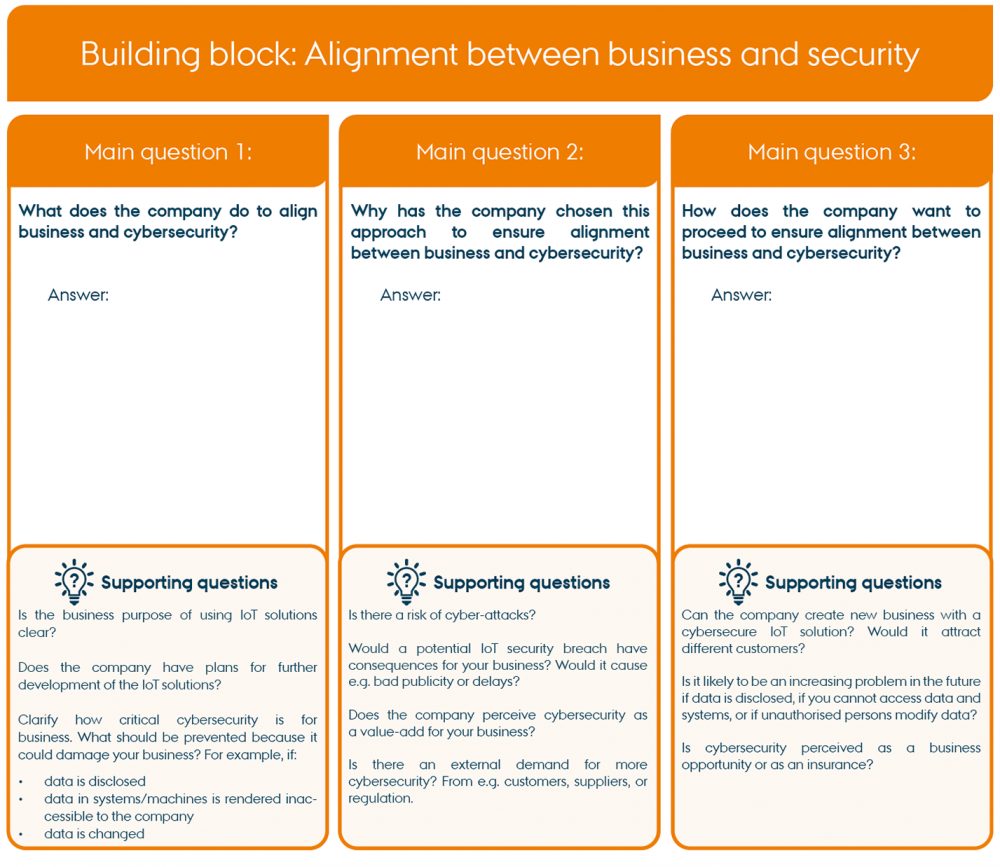Pre-analysis of the company’s situation
2022
The business analysis offers you an overview of your organisation's digital maturity, opportunities and threats in the market.
May 30, 2023
The purpose of this module is to conduct a situational analysis of the company’s cybersecurity.
The module is based on the four building blocks for cybersecurity, so it is necessary to be familiar with these building blocks in advance. The situational analysis tool provides insights into the company’s current approach to cybersecurity and facilitates the integration of the ongoing cybersecurity initiatives.
The aim of the tool is not to present an alarming view of the company’s cybersecurity; rather, it offers an experience-based view based on the current situation. A systematic overview of the current situation empowers the company to move forward with an open mind.
The four building blocks for cybersecurity outline the systematic approach required to effectively address cybersecurity in the company.
The building blocks serve as general descriptions that need to be adapted to the unique circumstances of the company, i.e., its current cybersecurity situation, processes, and business requirements.
The situational analysis forms the basis for this adaptation process throughout the company.
The company’s team performs a systematic analysis of practices in relation to cybersecurity within each building block and uses the analysis to assess the situation:
The tool will provide answers to questions like: How does the company solve cybersecurity tasks in a way that is aligned with the need for security, and what needs to be further developed if necessary?
The situational analysis enables the company to make informed decisions when adapting and prioritising cybersecurity tasks.
This is integral to anchoring cybersecurity successfully in the company.
A situational analysis will be carried out for each building block for cybersecurity. The purpose is to make a 360-degree description of how the company solves its cybersecurity tasks at present and evaluate next steps for each task.
The situational analysis is a simple exploration of the three main questions for each building block:
The four completed situational analysis sheets – one for each building block – maintain and structure the cybersecurity situation and serve as the foundation for making decisions on what the appropriate level of cybersecurity should be in the future.
Each work sheet contains three main questions in separate columns, including supporting questions for each main question. It is important that the company answers all three main questions for each building block and writes down the answers.
The supporting questions are examples of how the company could solve the cybersecurity task in focus in the situational analysis of the building block. The supporting questions cover considerations, possible decisions as well as specific tasks.
Note that the example shown in the work sheet below is the situational analysis for one building block: Alignment between business and security, and the task is the Business strategic task.

![]()
Worksheet for Situational analyses
Printable version of the tool for all four building blocks (large format)

In principle, you can carry out the situational analyses in random order, as you need all four analyses to establish a full picture. You can for example follow the steps below:

The situational analyses can be carried out at a joint meeting or individually.
The best way to do it is to ask everybody in the company who is involved in or responsible for cybersecurity to carry out the situational analyses together at a meeting with a duration of approx. 1,5 hours.
1) If more than three persons take part in carrying out the situational analysis, create smaller groups with two people.
2) Have a look at the main questions in the four situational analyses and agree on which order to complete them in (see example above). Follow this process for all situational analyses.
3) Start the situational analysis by answering main question 1.
4) Proceed to main question 2.
5) Finish by answering main question 3.
6) Reality check of the overall picture of the company’s cybersecurity
You have now completed an experience-based situational analysis of the company’s cybersecurity based on your specific context.
The insights obtained about the company’s current cybersecurity practices serve as a foundation for developing and anchoring cybersecurity throughout the entire company. Thus, the next steps in the process can therefore be implemented accordingly.
Experience shows that obtaining a systematic overview of the current cybersecurity situation enables the company to proceed with an open mind when it comes to further developing cybersecurity. Therefore, continue to practice active inquiry regarding cybersecurity based on these insights – especially because technological development does not stand still.
It is important to emphasise that a thorough initial analysis of current practice often shows that it is not at all necessary to change everything. That is also a valuable insight. Also, the analysis brings a sense of reassurance that cybersecurity is based on a common understanding of the needs for security in the company’s business. Working with the building blocks also provides the company with a common language for cybersecurity.
Next step is to prioritise the results of the four situational analyses. That means deciding where to put your efforts based on the systematic understanding of the company’s situation. Use the tool Prioritising building blocks for cybersecurity to begin prioritising.

The contents described above have been developed in the project:
’CyPro – Cybersecure manufacturing in Denmark’ by Aarhus University, Alexandra Institut, DAMRC, UGLA Insights and FORCE Technology funded by The Danish Industry Foundation. Material from the project is published under licence CC BY-SA 4.0
